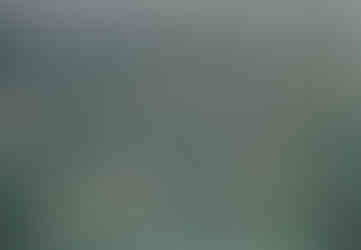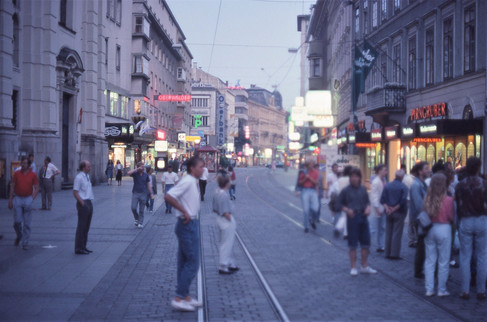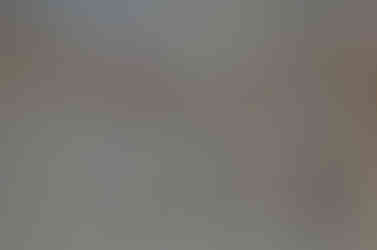BOXES 180-181: Austria, Hungary, and a Corner of Italy.
- Joe Milicia
- Apr 17, 2022
- 7 min read

Where are we? The pink-striped building with the Venetian-Gothic windows and the lion on the column may make you think of Venice, and rightly so, for this place was under Venetian governance for nearly 400 years. But it's Udine, in a northeastern corner of Italy, closer to Slovenia and Austria than to Venice. It was a stop during a car trip that began and ended in Zurich, circling through Austria and Hungary before continuing down to Italy and back up to Switzerland.
Our 1989 Sheboygan Symphony tour of Germany (see the previous two posts) ended at the Zurich Airport for a flight back to O'Hare, but a friend and fellow musician, Ellen Luebke, and I planned to extend our time in Europe with that drive. The only snag was that the car rental agency wouldn't allow an automatic-shift vehicle to be taken into Italy (too prone to being broken into, they said), so we had to take a stick shift. By this time, I'd learned to manage one, but Ellen couldn't, so I would have to be the sole driver. So, with our instruments (and my tux) shipped back with the SSO to Sheboygan, we headed eastward to Austria.
Our first overnight stay was just over the border in the very pleasant town of Feldkirch:


From there we continued on to Innsbruck, enjoying the Tyrolian vistas along the way:


Somewhere on this drive we saw this attractive house overgrown with vines and flowers:

I'd been in Innsbruck on my first European trip, in 1969 (see BOXES 36-37); this time we met up with a friend of mine, the art historian Mark Zucker, and his wife, Susan. (I'd ridden through central Italy with Mark in 1973: see BOXES 80-81.) I'm sorry I took no photos of the Zuckers in Innsbruck. As we continued on to Salzburg (which neither of us had ever visited), we passed a fantastically forbidding castle-fortress situated amidst the Alps:


Only now have I learned its name: Festung (Fortress) Hohenwerfen, built by the Archbishops of Salzburg in the 11th Century.
Salzburg is a great city for walking: fairly small and filled with handsome buildings, parks, fountains and views of the River Salzach and surrounding mountains. The next four photos show (1) the Chapter Fountain (Kapitelschwemme) with Hohensalzburg Castle standing above the town; (2) the Residenz Fountain with one side of the Cathedral behind it; (3) another McDonalds ironwork sign (not quite as beautiful as the one in Rothenburg I showed in BOXES 178-179); (4) a flowery garden with the Cathedral in the background and the Castle above it.


The next photo was taken from the Castle, looking down on the Cathedral in the far right foreground and the Franciscan Church with the sharp spire on the left:

It must have been from this vantage point that we could see the hazy nearby countryside as well:


I haven't been able to identify this next photo--maybe it's of an Archbishop's throne? We went to one concert while we were in Salzburg, a piano recital in a mirrored salon that Mozart would have played in--but it was Romantic and modern music on a modern piano, too loud for a small room. No photo, but I did take another panoramic view of the town, this one from a bluff looking toward the Castle:

Just outside of Salzburg we visited the gardens of Hellbrunn Palace. For some reason my photos were severely under- or overexposed, but I'll include them here, with some digital adjustment, just for the record of the trip:
Camera troubles persisted as we stopped at some Austrian lake and eventually reached the city of Linz, where you see their Cathedral in the background:
I assume the next two photos are also of Linz streets--I don't recall stopping in any other sizable cities before getting to Vienna:
My next two photos, of a baroque-era church or palace or monastery, are equally overexposed, but I kind of like their ghostly qualities. They were taken either in Linz or at Melk Abbey, our next stop, a large monastery complex on a bluff above the Danube.

Via Google Images I've been able to ID the rich interior of the church at the right: Melk Abbey. From there it was on to Vienna. Below is the last of this series of badly overexposed photos, this one of the Graben, the famous street in the Old City:

I took very few photos of Vienna on this trip, maybe because I had visited the city in 1972 (see BOXES 59-60) and didn't want to 'repeat' shots. But here's a shot outside the Kunsthistorisches Museum:


And here I am standing in front of 19 Berggasse, where Sigmund Freud lived and psychoanalyzed. I took one other picture of the address: it's accidentally under-exposed, but maybe that gives it a more "Freudian" quality:

I did 'repeat' shots of the Belvedere museum and its garden, though this time with Ellen in one photo:


And here are a couple of not quite 'postcard' views of sacred and secular Vienna landmarks: St Stephen's Cathedral with its striking zigzag roof pattern and the famous statue of Johann Strauss II:


Our last stop in Austria before crossing the border into Hungary was the town of Eisenstadt, the location of Esterhazy Castle (really more of a palace), where the Esterhazy Princes ruled for centuries and Joseph Haydn was in charge of the music:

Haydn had a house in the town, now a Haydn Museum:

We spent the next night over the border, in Sopron, Hungary, where I took this photo of the town's Fire Tower with its medieval and Renaissance elements:

Our drive took us across a portion of the great plains of Hungary:


. . . and to Eszterháza, the palace built in the 1760s by Prince Nicholas Esterhazy. (Not to be confused with Schloss Esterhazy, the Ancestral family seat in Eisenstadt we had seen the day before.) This is where Haydn and his musicians had to spend long months in the isolated countryside. My first photo, of an elaborate roofline sculpture, doesn't seem to be of the palace itself--maybe a carriage house? In any case, the next photo is definitely of the palace, with Ellen in front:

Closer views:


The interiors, including rooms where Haydn gave concerts, were pretty elegant:

My next two photos are of a body of water that must be the Danube after we left Eszterháza and continued on toward Budapest:
But it's definitely the Danube in the next shot, flowing through the center of the Hungarian capital. We're on the Buda side (where our lodging was), with Pest across the river:

This part of Buda, on a bluff, has an impressive set of terraces and monuments overlooking the Danube, with Buda Castle, a former palace now a museum, dominating the bluff. Here is part of a monumental gate with a mythic bird that is a symbol of Hungary:

And here's a closer view of the gate, plus some kids congregating around a fountain:
Part of the complex on Buda Hill is the Matthias Church, where some of the kings of Hungary were crowned:

And here is Fisherman's Bastion, built around 1900:



I wish I had taken more photos of the crowds around the complex, and especially of the excellent street musicians. But my next shot, from below Fisherman's Bastion, is of the Parliament Building across the river:

After crossing the Danube I took these photos looking back at Buda with the Matthias Church and the Castle:


Over the next couple of days we did a lot of walking through the streets of Pest, including some broad avenues with elegant though slightly faded buildings; but I'm now surprised to see that I took exactly two more photos while we were in the city. One is of a Victorian-era railroad station (Nyugati Station, built by the team that built the Eiffel Tower; there's another building to the left the mirrors the one we see on the right).

The other was taken in the New York Café, one of a number of such turn-of-the-20th-century establishments preserved in Budapest. As I recall, the lunch was excellent, and the exchange rate made the place, and Hungary in general, very affordable to us:

We next stayed at a resort on the south side of Lake Balaton, Hungary's largest lake:


I remember a restaurant where the specialty of the house was a whole pike-perch, fresh from the lake, cooked with crispy skin and mounted semi-vertically on the plate so that it looked like it was leaping from the water on a fisherman's hook. I greatly regret that I didn't take food pics in those days, and I can't even find an equivalent on the internet--maybe it's not served that way anymore. I see that I did take a photo of a pleasant pavilion in a nearby park:

The hills above Lake Balaton are prime Hungarian wine country:


Here's one more view of the hills near the lake:

I have only one other photo from this trip through Hungary: the waters of Heviz Spa, as we drove westward. We were originally going to swim in the outdoor thermal lake, but advertisements touted the therapeutic "radioactive" waters, and that made me reluctant to take a dip:

By this point on the trip I'd developed what I later realized was a sinus infection, which left me functioning but at a low energy level. I mention it because we were planning to reach Italy by winding our way through Slovenia, but because of the stick shift and my doing all the driving, we opted to take a westward route on the faster highways of southern Austria. (The infection may also be the reason I took fewer photos.) So my next shot is the one of Udine at the top of this post. While in that city we also visited the Castello di Udine (another "castle" that looks more like a palace and is now a museum) with its adjoining bell tower:

Nearby was perhaps Udine's most famous feature, the Loggia di San Giovanni, with its Venetian clock tower:



Just to the left of the Loggia and leading up to the Castello is the Bollani Arch, designed by Antonio Palladio, with a Lion of Venice above it and Ellen standing below.
These are the last of the photos I have of the 1989 SSO tour and drive through Austria, Hungary and Italy. Again I have a suspicion that there is a missing box of slides--after all, Ellen and I made stops in Verona and other places before heading north to visit my friend Heinz in Zurich, our last stop before flying home. Maybe they will turn up someday; in the meantime, in my next box of slides I'm back in Sheboygan, as I'll show in my next post.







































Comments